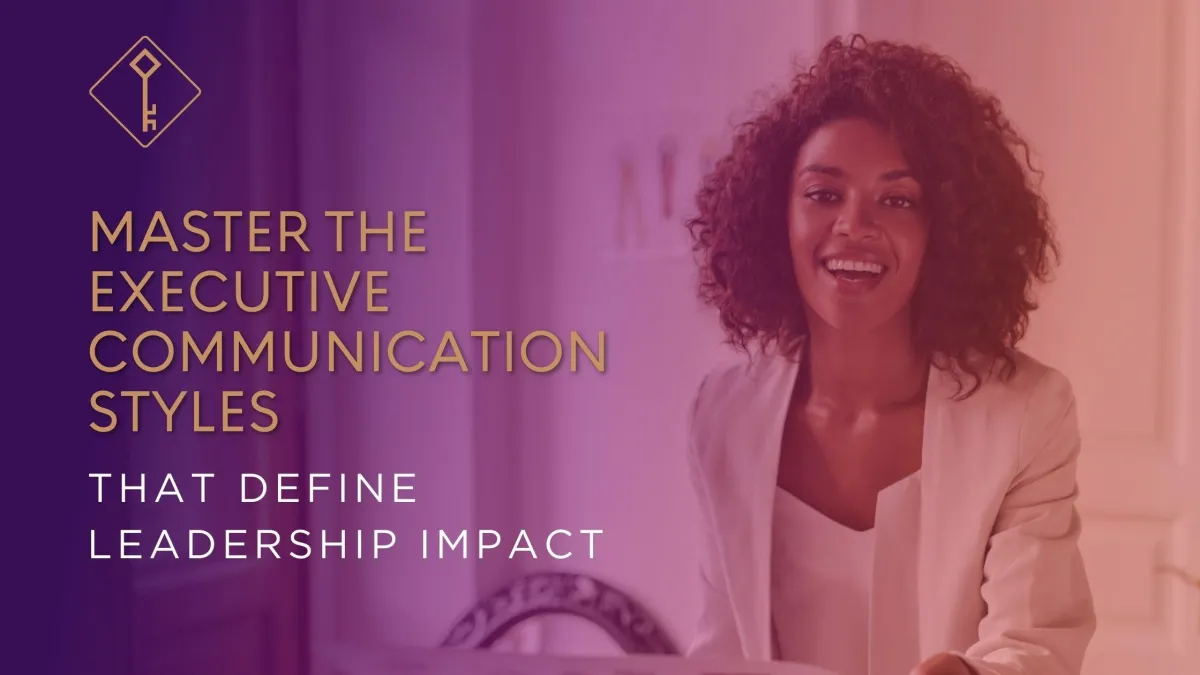
Master the Four Executive Communication Styles That Define Leadership Impact
Summary:
Most executives don’t lose influence because they lack strategy—but because they miscommunicate it. In this post, learn the 4 executive communication styles that every high-impact leader must master—and how to adapt your approach based on the moment, audience, and message.
Master the 4 Executive Communication Styles
Most executives don’t lose influence because they lack strategy—but because they miscommunicate it.
Leadership isn’t defined by vision, strategy, or even decision-making.
It’s defined by communication.
The greatest executives understand something most overlook:
How they communicate shapes organizational culture, team performance, and long-term legacy—often more than anything else they do.
But here’s where many leaders go wrong:
They fall into the trap of using a single communication approach—regardless of audience, situation, or stakes.
They speak to their board the same way they speak to their team.
They deliver performance feedback with the same tone they’d use for a keynote.
And then they wonder why their message doesn’t land.
This rigidity limits influence and erodes trust.
The solution isn’t complicated—but it does require awareness, intentionality, and range.
The Four Core Executive Communication Styles
Before you can adapt your style, you need to understand the core options available to you.
Each style serves a unique purpose and resonates with different audiences:
1. Directive Style
Clear, concise, outcome-focused
Ideal for crisis communication, high-stakes decisions, or urgent action
Answers the “what” and “when” directly
Use when clarity and decisiveness matter most.
2. Analytical Style
Logical, data-driven, detail-oriented
Builds credibility with technical teams and data-minded stakeholders
Addresses the “why” and “how” through evidence and reasoning
Use to support decisions, drive buy-in, and reduce emotion-based reactions.
3. Collaborative Style
Inclusive, question-based, consensus-building
Encourages participation and diverse input
Emphasizes “we” over “I”
Use when alignment, engagement, and ownership are critical.
4. Visionary Style
Inspirational, future-focused, emotionally resonant
Connects today’s work to tomorrow’s mission
Answers “where we’re going” and “why it matters”
Use to spark momentum and lead change.
Identifying Your Default Style
Every leader has a go-to style—often developed through habit, past success, or personality.
Ask yourself:
Under pressure, how do I tend to communicate?
What kind of feedback do I receive about my communication tone?
Which audiences respond best to my natural style?
Your default isn’t wrong—but over-relying on it limits your leadership effectiveness.
Matching Style to Situation
The best communicators don’t just talk—they adapt.
They read the moment, the room, and the relationship—and then choose the right style.
Consider:
Crisis: Go Directive—clear, swift action wins
Strategic Planning: Blend Analytical + Collaborative—data meets dialogue
Change Initiatives: Go Visionary—connect the change to meaning
Performance Feedback: Mix Analytical + Collaborative—evidence + solutions
The best leaders don’t just communicate—they diagnose the moment and tailor their message to match it.
Practical Techniques to Expand Your Range
To increase your communication flexibility, try these techniques:
Prepare with intent: Ask, “What does this audience need from me right now?”
Balance statements vs. questions: More statements = directive. More questions = collaborative.
Adjust pace and pauses: Visionary = dynamic rhythm. Analytical = measured flow.
Shift your language: Directive = action verbs. Visionary = sensory, forward-thinking language.
Practice with feedback: Ask trusted colleagues which style you naturally lead with—and how effectively you adapt.
Pitfalls to Watch For
Authenticity concerns: Flexibility is not manipulation. It’s leadership awareness.
Overcorrection: Subtle shifts work better than dramatic swings.
Misreading the room: Stay tuned in and pivot when needed.
Inconsistency across channels: Aim for consistency in tone, even if the delivery method changes.
Build Your Communication Growth Plan
Make your development intentional. Try this:
Identify the style you need to strengthen.
Choose 2–3 real scenarios this month to practice it.
Get feedback (formal or informal).
Reflect and adjust.
Work with a coach or mentor to refine in real-time.
The Competitive Advantage of Communication Range
The ability to shift styles without losing authenticity is a leadership superpower.
It increases your credibility, strengthens team trust, and helps you move through complexity with more ease and influence.
In a world where technical skills are easy to replicate, your communication remains your most durable advantage.
Because it’s not just what you say.
It’s how you say it—and how well it lands.
Master both, and your leadership will speak for itself.
Want help identifying your default communication style—and strengthening your leadership voice across every room you walk into?
Discover Your Powerhouse Communication Style
Before you can adapt your style, you need to know where you're starting from.
That’s why I created the Powerhouse Communication Style Quiz—a quick and revealing tool that helps you uncover your natural leadership voice.
You’ll discover whether you’re leading as a:
Doer – Direct, decisive, and outcome-oriented
Connector – Collaborative, people-first, and relational
Influencer – Visionary, expressive, and purpose-driven
Thinker – Analytical, precise, and data-informed
Each style brings its own strengths—and blind spots.
Your default communication style isn’t a weakness, but when applied universally, it can dilute your message and unintentionally create friction.
When you take the quiz, you'll also receive the Powerhouse Communication Playbook, a custom guide designed to help you:
Understand the impact of your style
Identify when to flex toward another approach
Strengthen your executive voice for different audiences and moments
🎯 Take the Quiz + Get the Playbook
Final Thought
Communication isn’t just about clarity—it’s about connection.
The most powerful leaders aren’t the ones who speak the most, but the ones who know how to speak to the moment.
You don’t need to change who you are.
You just need to learn how to express it in a way that lands.
Know your voice. Use it with intention. Lead with impact.
You Might Also Like:
How Executives Can Leverage LinkedIn
How to Position Yourself as a Recognized Authority
The Science of Influence & Executive Presence

